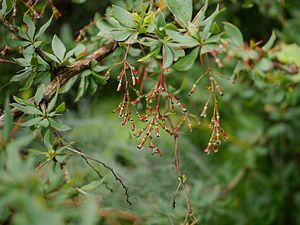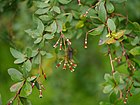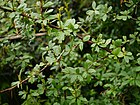Note: This is a project under development. The articles on this wiki are just being initiated and broadly incomplete. You can Help creating new pages.
Berberis chitria
Berberis chitria is an erect, spiny, evergreen shrub. It can grow up to 5 metres tall. The plant is harvested from the wild for local use as a medicine and for food. It is sometimes grown as an ornamental in gardens.
Contents
[hide]- 1 Uses
- 2 Parts Used
- 3 Chemical Composition
- 4 Common names
- 5 Properties
- 6 Habit
- 7 Identification
- 8 List of Ayurvedic medicine in which the herb is used
- 9 Where to get the saplings
- 10 Mode of Propagation
- 11 How to plant/cultivate
- 12 Season to grow
- 13 Required Ecosystem/Climate
- 14 Kind of soil needed
- 15 Commonly seen growing in areas
- 16 Photo Gallery
- 17 References
- 18 External Links
Uses
Peptic ulcers, Various eye inflammations, Bacterial dysentery, Enteric infections.
Parts Used
Chemical Composition
Isoquinoline alkaloids are the major bioactive constituents in Berberis.[1]
Common names
| Language | Common name |
|---|---|
| Kannada | |
| Hindi | |
| Malayalam | |
| Tamil | |
| Telugu | |
| Marathi | |
| Gujarathi | |
| Punjabi | |
| Kashmiri | |
| Sanskrit | |
| English |
Properties
Reference: Dravya - Substance, Rasa - Taste, Guna - Qualities, Veerya - Potency, Vipaka - Post-digesion effect, Karma - Pharmacological activity, Prabhava - Therepeutics.
Dravya
Rasa
Guna
Veerya
Vipaka
Karma
Prabhava
Habit
Identification
Leaf
| Kind | Shape | Feature |
|---|---|---|
Flower
| Type | Size | Color and composition | Stamen | More information |
|---|---|---|---|---|
| {{{5}}} |
Fruit
| Type | Size | Mass | Appearance | Seeds | More information |
|---|---|---|---|---|---|
Other features
List of Ayurvedic medicine in which the herb is used
Where to get the saplings
Mode of Propagation
Seeds, Cuttings of half ripe wood, Cuttings of mature wood.
How to plant/cultivate
Prefers a warm moist loamy soil and light shade but it is by no means fastidious, succeeding in thin, dry and shallow soils.[3]
Season to grow
Required Ecosystem/Climate
Kind of soil needed
Commonly seen growing in areas
Photo Gallery
References
- Jump up ↑ Chemical constituents
- Jump up ↑ [Morphology]
- Jump up ↑ Cultivation
- Jump up ↑ Cite error: Invalid
<ref>tag; no text was provided for refs namedSeason to grow - Jump up ↑ Cite error: Invalid
<ref>tag; no text was provided for refs namedRequired Ecosystem/Climate
External Links
- Pages with reference errors
- Ayurvedic Herbs known to be helpful to treat Peptic ulcers
- Ayurvedic Herbs known to be helpful to treat Various eye inflammations
- Ayurvedic Herbs known to be helpful to treat Bacterial dysentery
- Ayurvedic Herbs known to be helpful to treat Enteric infections
- Herbs with Fruits used in medicine
- Herbs with Roasted seeds used in medicine
- Habit - Evergreen shrub
- Index of Plants which can be propagated by Seeds
- Index of Plants which can be propagated by Cuttings of half ripe wood
- Index of Plants which can be propagated by Cuttings of mature wood
- Herbs that are commonly seen in the region of Moist places
- Herbs
- Pages without herbs images





